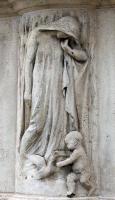
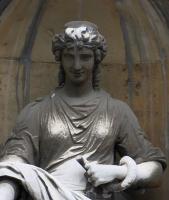
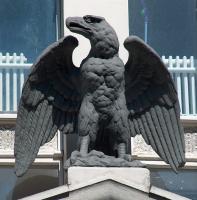
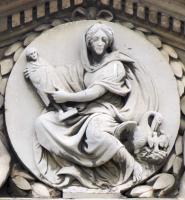
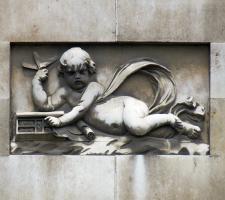
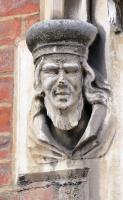
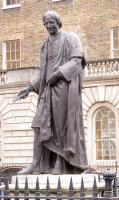
There are three main works of sculpture on Borough High Street, and more in the Church.
But we start down St Thomas Street, street at the north end of Borough High Street, wherein is the principal entrance to Guy’s Hospital, with a statue of Sir Thomas Guy, the founder, in the courtyard, and the central range of the building behind with architectural figure sculpture.
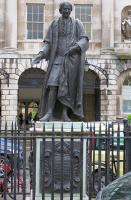
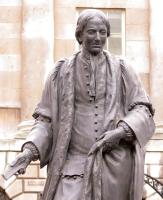 Sir Thomas Guy, by Scheemakers.
Sir Thomas Guy, by Scheemakers.
The bronze statue shows Sir Thomas Guy standing in informal repose, wearing a buttoned shirt and tunic, long boots, and a cloak or mantle on top, trimmed with fur, which combined with the extravagantly large shirt cuffs, show a man of wealth. In one hand he holds some paper, perhaps relating to the deeds establishing the hospital or its plan, and with his other hand he holds up a fold of his cloak. As depicted in the statue, he is of youthful middle age, with centre-parted hair combed wavily backwards and then cut straight in not particularly flattering fashion. His face is somewhat proud and self-pleased. The lines of the hands and the opposing angle of the hem of his raised cloak make a pleasing zig zag composition to the figure.
He stands upon a stone plinth, with a cartouche and inscription on the front, and minor figure sculpture on the sides: the Good Samaritan and Christ healing a man; the rear has Guy’s coat of arms. Peter Scheemakers was the sculptor, and the date on the front of the statue is 1721 (Sir Thomas died three years after this date).
Central range of Guy's Hospital, 1778, and cherubs, by Bacon the Elder.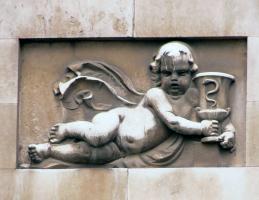
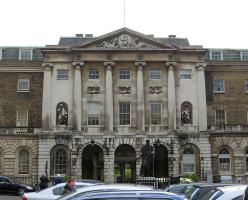
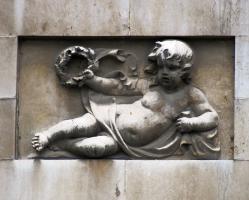
The central building behind, of Portland stone, is five bays wide, with Ionic pillars from 1st to 2nd floors, supporting entablature and pediment. It was refaced in 1778 or thereabouts, and this is the façade we see today. The three centremost bays include at second floor level panels with carved naked putti, ghastly things shown in reclining attitudes (if you like them, then lots more on this page). One has an unrolling bandage, perhaps, from a box, and holds some tab-like things in his hand (see picture at top of page); the central one holds a wreath of oak, and the third a cup, doubtless representing some healing draught, for upon it is carved in low relief the snake of Aesculapius – see this page.
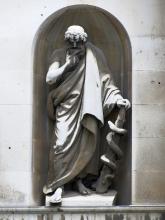
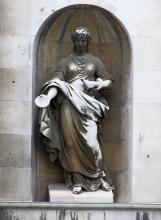 Aesculapius and Hygieia, by Bacon the Elder.
Aesculapius and Hygieia, by Bacon the Elder.
The side bays are recessed, and each bears at first floor level a full standing statue in a niche. To the left as we look at the building is Aesculapius himself, shown as an elderly bearded philosopher wearing a great sweeping cloak, sandaled feet protruding bonily underneath. One muscular had is used to rest his heavily bearded head, for the sculptor has depicted him deep in thought; the other holds his staff, more a club, with a fairly large snake twisted around it. A noble conception. The other figure, female, is Hygieia, Goddess of Health, a graceful figure in long Greek robes, with a twist of heavier drapery looped across her front and over her outstretched arm, which holds a small bowl. Around her other hand is looped a much smaller snake. Rather a curvy figure, most feminine, but with a solidity and muscularity that gives a certain presence - for more statues embodying Health, see this page. Both figures have a goodly degree of ingrained dirt, emphasising the changing contours and the depth of the undercut drapes.
The pediment group consists of a central roundel with a female figure in relief, and two much larger figures reclining against it to the sides. The central female is seated, holding a small sculpture of a man, presumably Sir Thomas Guy again, while behind her leg is a rendering of the Pelican feeding her young, here a representation of the sacrifice made to protect the helpless rather than with the usual religious connotations - click on the picture at the top of this page to see the detail.
All this is the work of John Bacon the Elder, an important sculptor, resident of Southwark. Within the chapel of the Hospital is Bacon's grand memorial to Thomas Guy, and elsewhere his work includes the statue of King William III in St James Square (completed by his son), and numerous other monuments, including that to Pitt the Elder in the Guildhall.
Just round the corner, on the railings next to the road is some modern metalwork, three panels representing themes of giving,by Sir Thomas Guy, by visitors and by staff, including a grapevine, simple figures, a hospital bed, and representative accoutrements including a microscope. Made by George James & Sons, Blacksmiths.
Modern plaque by George James & Sons, and St Thomas Church.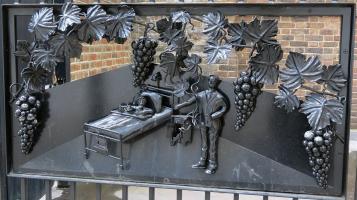
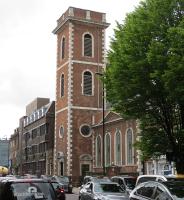
Walking along St Thomas’s Street west to Borough High Street, where our other sculpture is, the main feature is the brick tower of St Thomas Church, dating from the 1700s and now housing the Old Operating Theatre Museum.
The Borough War Memorial, put up in 1922, stands where Borough High Street splits in two, and consists of a bronze figure of an infantryman soldier on a stone plinth, with bronze panels on the sides and stone sculpture on the front and rear.
Borough War Memorial, by P. Lindsey Clark.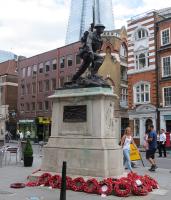
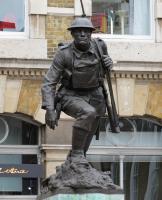
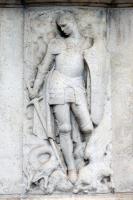
The soldier is advancing over rough ground, one leg forward, the other stretched far back, a crouched down posture giving him a look of dynamic movement. One hand holds the strap of his bayonet, which is on his back and points sharply upwards adding to the dramatic silhouette, the other is loosely at his side.
The two bronze panels show firstly a nautical scene with two big naval guns in the foreground and a low relief battleship behind, beneath a cloudy sky; and secondly, and rather more exciting, an air battle, with three biplanes in close proximity, and a fourth plane billowing with smoke. On the front of the base is a St George and the Dragon; St George stands bareheaded, in plate mail with shield and downward pointed sword, standing on the back of the collapsed, rather serpentine-necked dragon - for more examples of this subject, see this page. St George’s short-cropped hair is typical of early 20th Century sculpture, but would have been unusual even a few years earlier. The sculpture on the rear of the monument shows a veiled girl, head bowed, in an attitude of mourning, while her naked infant gambols at her feet (see picture at top of page). Both this figure and the St George are already rather battered by weather and pollution which attacks the limestone, but are interesting in showing more allegorical figures, a rarity with the sculptor, P. Lindsey Clark.
Borough War Memorial, bronze plaques.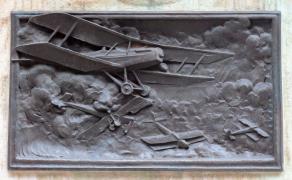
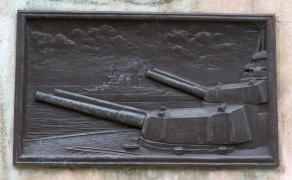
P. Lindsey Clark, the sculptor of the Southwark War Memorial, is not such a familiar figure, like so many of the early 20th Century sculptors who spanned that uneasy period where figure sculpture went out of vogue. Apart from the Borough War Memorial, he made one by the Kelvingrove Art Gallery, Glasgow, the Cameronians Memorial, with one figure in a similarly crouched and advancing position. His later work is mostly religious, principally for Catholic churches, as well as a small amount of architectural sculpture.
On the wall of the building behind the main War Memorial is a bronze plaque in memory of the men of the London Hop Trade who fell in World War I, with St George shield at the top, and two festoons of grapevines. This introduces us to two buildings connected with the hop industry, which was and is significant in Kent.
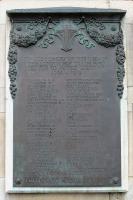 WW1 Plaque to men of the London hop trade.
WW1 Plaque to men of the London hop trade.
Close to the War Memorial, across the road to the right as we face north, is the one-time premises of W.H. and H. Le May, Hop Factors, no. 67 Borough High Street, with a nice terra cotta plaque with their name, and delicate sculptural decoration. A male and a female figure, he in a short tunic and she in a smocklike garment, stand to each side, like supporters to a shield of arms. Each looks upwards to the vine which they hold, and each in their other hand holds a basket brimming with hops and leaves. The vines rise up the sides of the plaque and over the top, and low relief branches stray across the front of the plaque, more illustration than sculpture. The building is one of a number of surviving Victorian frontages along Borough High Street, which was laid out early in the 1860s by the engineer Sir Joseph Bazalgette, who is best known for the Victoria Embankment, where his portrait sculpture can be found. The best known building here of these times is Borough Market.
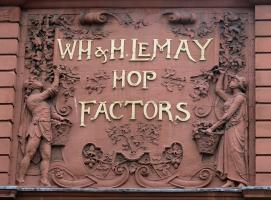
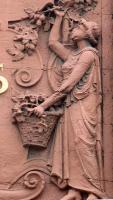 Terra cotta sign for Hop Factors.
Terra cotta sign for Hop Factors.
The Hop Exchange in Southwark, on Southwark St, just round the corner, is one of those fantastic Victorian buildings made by repeating a single element multitudinous times, in this case a bay with Corinthian attached pillars to each side on the ground floor, shallow-arched windows with tall keystones to the first floor, and above, double height round-arched windows and a cornice. There are over 30 of these bays, and rather to the right hand side as we look at the building from the other side of the road, to be closer to Borough High Street, is the entrance, a portico up to the top of the first floor, with three entrances between pillars, ornate ironwork above, three keystone heads of serious size, and a pediment with an agricultural scene. On top of the pediment is a fierce eagle, wings partly outspread, glaring to one side so we can see the hooked beak (more eagle sculpture can be seen on this page). The architect was R. H. Moore, and the building was put up in 1866.
Hop Exchange, and details of portico and sculpture.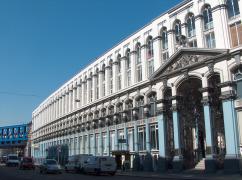
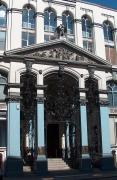
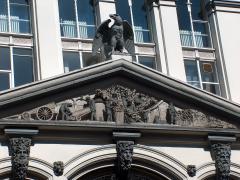
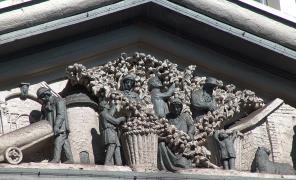
The centrepiece of the pediment shows half a dozen figures, including men, women and two children, pulling down the hop vines to pile them in an overflowing basket – they look rather like grape vines, but hops are what they must be. To the left is an oast house (for roasting the hops),and two men with some sort of hopper in front of a factory building with its own mini-keystone head; in the thin corner of the pediment is what appears to be a large bellows on wheels, perhaps for increasing the heat of the fire heating the hops. The equivalent scene to the right shows a shepherd standing in front of his hut, shapeless dog or perhaps a sheep resting next to him, and a field of ripe corn or barley for the brewing of the beer. The scene is better carved than the figures, which are chunky and no better than illustrative; they are picked out in grey paint against the white scene so we can see them readily from below. The sculptor is unknown, at least to me.
More carefully carved, but perhaps by a different hand, are the three keystone heads, typical of the breed, here a central Goddess and two flanking Gods of the forests. All of them have their heads surrounded with leafy branches with abundant hops. For more on bearded keystone heads like those on the sides, see this page; for female keystone heads like the one in the middle, see this page.
There are various Victorian buildings to be seen along Borough High Street and down some of the side streets, notably a stag on the High Street itself, and along Newcomen Street, which afterwards becomes Union Street, where there is a nondescript building built for Marshall’s Charity which has a series of protruding carved heads. They are nicely medieval in style, and we see grimacing monks and ecclesiastics, kings and queens and nobles, simply made but characterful. Would that there were more such.
Marshall's Charity building, sample carved heads.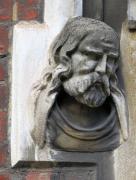
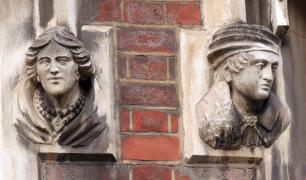
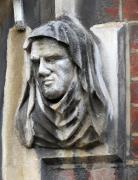
Finally, we may note that to the north of Borough High Street is Southwark Cathedral, which has extremely good monuments, not covered on this website, and as we go south, actually on Borough High Street and sticking out far enough that its tall spire forms the principal viewpoint for the pedestrian, is St George the Martyr. From the outside, the building presents a noble portico to the street, and being on an island site, we can walk entirely around the building to appreciate it from a range of vantage points, one of which is given in our picture below. It is the work of the architect John Price, and was erected in the 1730s. Inside is an original Georgian interior, a splendid turn of the 19th Century decorated ceiling to the design of Basil Champneys, and a large number of modest memorial plaques, a few of which have some sculptural element: see this page.
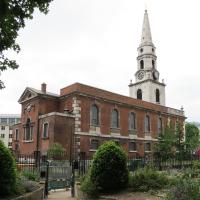 St George the Martyr, Borough High Street.
St George the Martyr, Borough High Street.
Trinity Church Square statue and Church nearby // Mosaic in Red Cross Garden nearby // Eastwards to Tooley Street statues, Bermondsey
Or eastwards from St George the Martyr along Long Lane to St Mary Magdalene, Bermondsey
Borough to Bermondsey: churches and sculpture // London sculpture // Sculptors
Visits to this page from 16 Nov 2015: 5,058